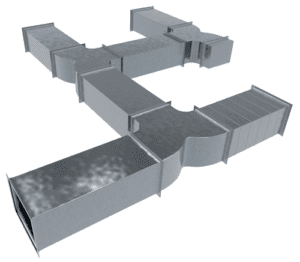Is your HVAC duct insulation falling apart or otherwise showing signs of disrepair? If so, it might be time to bring an HVAC specialist into your home to check everything and replace the insulation. While the insulation condition is not quite as critical as the condition of the duct itself, it can impact your energy consumption and utility bills, and the overall temperature of your home.
Why Duct Work Insulation Matters

If you find duct insulation that’s dilapidated, wet, moldy, or torn apart from people accessing your crawlspace, your best bet is probably to remove it and start anew. Air duct insulation is tough to clean or remediate. Especially if it has become wet, the only way to proceed is to trash the old materials and replace them with new insulation. Now, you may find yourself wondering: do I really need ductwork insulation?
There are homes—particularly new construction houses—that do not have HVAC duct insulation. They leave conduits exposed and visible on the basement ceiling. However, just because some builders go this route doesn’t mean it is wise. A lack of duct insulation poses three problems for your home: high energy usage, expensive utility bills, and inconsistent temperatures inside.
When your HVAC system heats or cools your home, the air must travel through the duct network to various vents throughout your home. These channels’ job is to distribute air throughout the home, thereby creating consistent temperatures in every room in the house. This temperature should match the temperature you have set on your home’s thermostat.
Most ducting is made of either thin fiberglass or sheet metal. These materials have next to no insulating properties on their own, which means they very quickly lose (or “leak”) air as it moves through the ducts. Leaking air means that the air temperature moving through the channel is profoundly influenced by the temperature outside. Insulation on ducts does an excellent job of preventing air leaking, which means the air stays at or near the desired temperature as it moves through the passage to your heating and cooling vents.
Without HVAC duct insulation, though, you have a problem. Imagine trying to heat your house during the winter. Imagine that it’s -10 degrees outside, and some of that frigid air is getting into your house and into the room (usually the basement) where the ducting is housed. Now, imagine that your air channel system is unprotected by duct insulation. You are asking your HVAC system to pump warm air through a cold room with nothing to insulate it but sheet metal. Without a doubt, there are going to be problems with heat leaking. The warm air will lose temperature as it moves through the ducts, making it more difficult to heat the house satisfactorily. You will have the same problem trying to cool your home in the summer.
The Cost of Uninsulated Ductwork
Still, air leaking is costly. When air is heated, or cooled moving through the ducts, it’s essentially losing energy. Your HVAC is working to maintain your home’s thermostat temperature, but its efforts aren’t successful because the air coming through your vents isn’t the right temperature. As a result, the HVAC system must work harder (and heat/cool the air more) to achieve and maintain your thermostat reading. Mostly, you end up using more energy and spending more money for less consistent and less satisfying interior temperatures.
There is also the problem of condensation. When warm air meets a cold surface, water droplets form. This issue can occur in or on HVAC duct insulation when air leaking is a problem. In turn, Moisture buildup leads to mold and mildew, which can impair the air quality in your home and pose a significant health risk.
Ultimately, uninsulated ductwork can cost you in terms of energy, comfort, money, and health. None of these costs are worth paying— primarily when you can mitigate the problem so easily with insulation.
The Verdict: Replacing Old Ductwork Insulation
The question posed by this blog post was whether you should replace your ductwork insulation if it is looking messy or damaged. The answer, as you have probably already gathered, is yes. If you notice a problem with your HVAC duct insulation—or if you see that part of the air channel was left uninsulated by a builder or previous owner—you should call a ducting expert to replace your insulation and seal the ducts. Fixing the issue now will save you money and headache later. You might also consider cleaning the ducts to ensure premium performance.
Check with us here at Valley Comfort Heating and Air. Our customers love our attention to detail and our friendly, affordable service. (707) 539-4533

